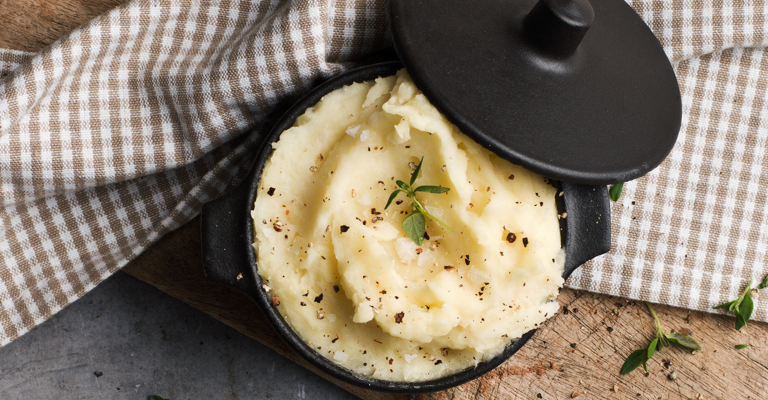


One of the most important things to avoid when making mashed potatoes is to use a power blender of any sort. Blending the potatoes will result in a heavy, almost glue-like paste. Instead, use a simple masher or a potato press, followed by a spoon or a slow electric whisk to stir in the cooking cream and milk. Another tip is to add the milk and cooking cream gradually to help the potatoes absorb the liquids. Finally, don’t overmix your mash. Overmixing will make your mash dense and pasty instead of light and fluffy.
Heating your milk and cooking cream before adding them to the mash will help the potatoes to absorb and integrate the liquids. Cold milk will not mix as well with the mash. This may tempt you to overmix the mash, turning it dense and pasty.
While boiling is the classic way to make your potatoes mashable, baking is a great alternative. As long as you give them enough time to soften properly, your potatoes will come out of the oven full of flavor and with minimal moisture. This is a great starting point for great mash. You can also add a halved bulb of garlic to the potatoes before baking. Then squeeze some baked garlic cloves into the mash for amazing, deep flavor.
A generous serving of warm and fluffy mashed potatoes is a great accompaniment to almost any meat, fish, or veggie dish. Mastering the art of mash will make you a hero at every family dinner and get-together.
Spanish explorers brought the domesticated South American potato to Europe in the 16th century. But it wasn’t until the second half of the 18th century that a French army pharmacist, Antoine-Augustin Parmentier, started a campaign to convince people that potatoes are fit for human consumption and not only as animal feed. Mashing the potatoes was one method that Parmentier recommended. Potatoes mashed with milk and butter are found in recipe books from the 18th century and onwards.
Delicious mash requires the right kind of potato. Choosing a potato that is high in starch is the first step to fluffy, airy mash. Which kind of potato this is depends on your location in the world. Russet and Yukon Gold are popular for mashing in the Americas, while King Edward and Maris Piper are more common in Europe and other parts of the world.
There are plenty of herbs, spices, and seasonings that can help bring your mashed potatoes into gourmet territory. Garlic is one of them. You can let a couple of garlic cloves boil and be mashed with your potatoes for added flavor. Or simply use garlic powder to season your mash. Once the garlic is in place, some chopped parsley, rosemary, or thyme can add lovely color and flavor. A classic spice for mashed potatoes is freshly ground nutmeg, just a pinch. You can also try adding cayenne or chilli powder for added heat in your mash, or a little bit of lemon juice to really bring out the flavor of the potatoes.

Fall in love with pasta all over again, as you serve your loved ones creamy dishes made richer with Puck—and your special touch. Our inspiring recipes, general guidelines, and detailed articles will set you on the path to culinary creativity. With Puck’s entire range of cooking creams and sauces that meet your high standards, you’ll love putting your personal spin on pasta.